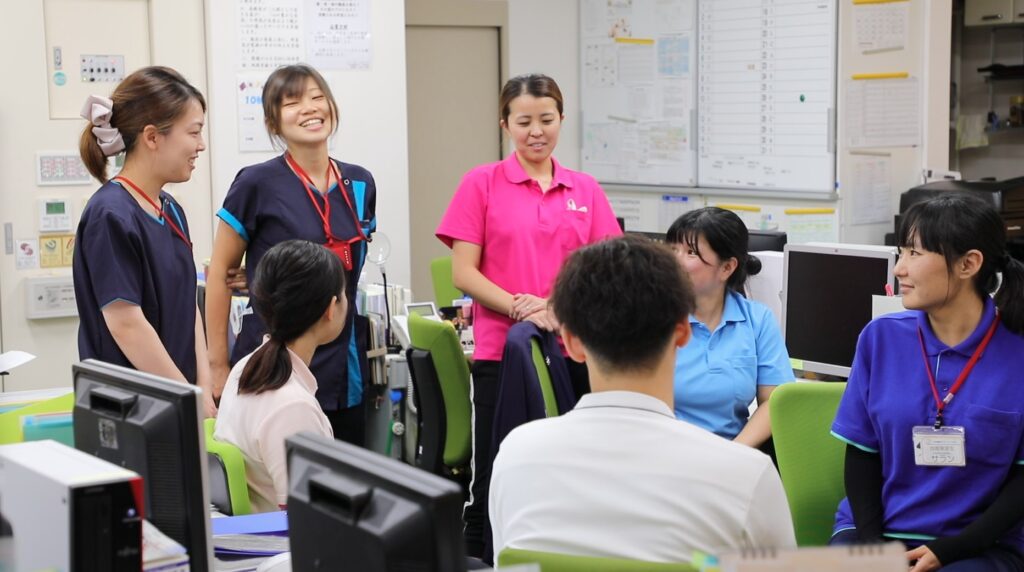When working on-site in long-term nursing care, many of the same phrases and technical terms are used frequently, both in conversations between staff members and in patient records. It is very important to understand such technical terms and common phrases in order to understand the physical condition of one’s elderly patients and to work together effectively with other long-term care nursing staff members. Learning this new vocabulary might seem difficult at first, but together, we can do it.
Contents
Phrases used among staff members
- 「バイタルチェック」(BAITARU CHEKKU) – checking a patient’s vital signs
Measuring a patient’s vital signs (body temperature, blood pressure, respiration, pulse). This must be done every morning and before the patient takes a bath in order to ensure that all staff members are aware of the physical condition of their elderly patients.
例:「◯さんの朝のバイタルは正常です、いつもと変わりありません」
Example: “Mr. ◯’s morning vital signs are normal, same as usual.”
- 「見守り」(みまもり)(MIMAMORI)
Helping immediately when needed and doing whatever you can to keep patients safe. This also refers to observing your elderly patients prevent falls or other accidents.
例: 「◯さんは、歩くときにふらつくことがあるので、見守りをしましょう」
Example: “Mr./Mrs. ◯ may wobble while walking, so make sure to observe (mimamori) him closely to keep him safe.
- 「処置」(しょち)(SHOCHI)
Giving treatment such as disinfecting or applying medicine to body parts with problems such as injuries or bedsores.
例: 「腕に傷があるので、看護師に処置をしてもらいましょう」
Example: “There is a cut on that arm, so let’s get a nurse to apply (shochi) the right treatment to it.”
- 「失礼します」「失礼しました」(しつれいします)(しつれいしました)(SHITSUREI SHIMASU)(SHITSUREI SHIMASHITA)
This phrase is used before and after assisting our elderly patients or entering or exiting their rooms. It is especially important to be considerate of the fact that our elderly patients’ living space is a private area, so be sure to use this phrase when entering or exiting this space.
例:「失礼します。◯さん、お部屋に入らせていただきます」
Example: “Excuse me, Mr./Mrs. ◯ — I’m going to come into your room now.”
- 「発赤・浮腫」(はっせき) (ふしゅ) (HASSEKI) (FUSHU) REDDENING, SWELLING
皮膚 (HASSEKI ) refers to reddening of the ski, while 浮腫 (FUSHU) refers to swelling. In our elderly patients, these can be caused by illnesses and have effects on their overall health. Observing patients closely and sharing information with other staff members can allow for earlier treatment of these problems.
例:「足に浮腫がみられます。(臀部に)発赤を見つけました、あります」
Example: “There is swelling in the feet, as well as redness (on the buttocks).”
Other Phrases
- 「◯さんは、部屋で休んでいます」
”Mr./Mrs. ◯ is taking a rest in his/her room now.”
- 「◯さんは、食事を残したので、体調に気をつけてください」
“Mr./Mrs. ◯ did not eat their meal, so please keep an eye on his/her physical condition.”
- 「◯さんは、顔色が悪いので体調の変化に気をつけ、観察してください」
“The color of Mr./Mrs. ◯’s face looks off, so please keep an eye on his/her physical condition.”
Overall, the important thing to know is that staff members should report any change, no matter how small, in the physical condition of one of our elderly patients to their colleagues.
Long-Term Nursing Care Technical Terms to Remember
When working on-site in long-term nursing care, many of the same technical terms are used frequently, both in conversations between staff members and inpatient records. It is very important to understand such technical terms and common phrases in order to understand the physical condition of one’s elderly patients and to work together effectively with other long-term care nursing staff members. There are some difficult kanji in these words, so let’s be sure to sound them out and read them aloud.
- ケアプラン (KEA PURAN) (CARE PLAN): a long-term care plan that describes the type, and frequency of the long-term care that an elderly patient is receiving, as well as the goals of this care in terms of what kind of life the elderly patient and their family expect to live. Care plans are regularly reviewed to ensure that they match the elderly patient’s current condition. Our long-term nursing care services are based on each care plan.
- 受診 (JUSHIN) (DOCTOR CONSULTATIONS): Seeing a doctor. Doctors may visit the patient in the facility or the elderly patient may go to the hospital with a staff member or family member to consult with a doctor.
- 水分補給 (SUIBUN HOKYU) (HYDRATION): Receiving the necessary liquids (hydration) from food and beverages that the body requires. Elderly people are less likely to recognize their own thirst, so encouraging them to hydrate frequently is important.
- 体位変換 (TAII HENKAN) (CHANGING BODY POSITION): Changing the position of a patient’s body when he/she cannot turn to overuse his/her own power. Sleeping solely in the same position can impair blood flow and may cause pressure sores (bedsores).
- 着脱 (CHAKUDATSU) (CHANGING CLOTHES): Putting on or taking off clothing.
- 熱発 (NEPPATSU) (FEVER): When body temperature rises above normal due to illness or poor physical condition. The general wisdom is that a fever involves body temperatures of 37.5 degrees Celsius or higher, but because normal body temperature varies from person to person, meaning that it is most important to notice when the body temperature rises above normal as well changes in the patient’s physical condition.
- ベッドメイキング (BEDDO MEIKINGU) (BED MAKING): Replacing sheets, duvets, pillowcases, etc. Doing so regularly keeps our elderly patients clean and sleeping soundly.
- 面談 (MENDAN) (CONSULTATION): Discussions involving the elderly patient, his/her family members, and long-term nursing care staff about the patient’s health, daily life, problems or issues, and desired lifestyle. These are held before entering the facility and then again regularly as the care plan is reviewed.
- 配膳 (HAIZEN) (MEAL SERVICE): Serving a meal on the patient’s table, including setting tableware and chopsticks in positions that make it easy for the elderly patient to eat.
Our collection of links also includes a glossary that summarizes terms used in long-term nursing care work. Please make full use of this resource.

